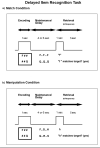An fMRI investigation of cerebellar function during verbal working memory in methadone maintenance patients
- PMID: 21892700
- PMCID: PMC3248617
- DOI: 10.1007/s12311-011-0311-0
An fMRI investigation of cerebellar function during verbal working memory in methadone maintenance patients
Abstract
Working memory is impaired in opioid-dependent individuals, yet the neural underpinnings of working memory in this population are largely unknown. Previous studies in healthy adults have demonstrated that working memory is supported by a network of brain regions that includes a cerebro-cerebellar circuit. The cerebellum, in particular, may be important for inner speech mechanisms that assist verbal working memory. This study used functional magnetic resonance imaging to examine brain activity associated with working memory in five opioid-dependent, methadone-maintained patients and five matched, healthy controls. An item recognition task was administered in two conditions: (1) a low working memory load "match" condition in which participants determined whether target letters presented at the beginning of the trial matched a probe item, and (2) a high working memory load "manipulation" condition in which participants counted two alphabetical letters forward of each of the targets and determined whether either of these new items matched a probe item. Response times and accuracy scores were not significantly different between the groups. FMRI analyses indicated that, in association with higher working memory load ("manipulation" condition), the patient group exhibited hyperactivity in the superior and inferior cerebellum and amygdala relative to that of controls. At a more liberal statistical threshold, patients exhibited hypoactivity in the left prefrontal and medial frontal/pre-SMA regions. These results indicate that verbal working memory in opioid-dependent individuals involves a disrupted cerebro-cerebellar circuit and shed light on the neuroanatomical basis of working memory impairments in this population.
Figures




References
-
- Baddeley A. Working memory. Science. 1992;255(5044):556–9. - PubMed
-
- Ackermann H, Mathiak K, Ivry RB. Temporal organization of “internal speech” as a basis for cerebellar modulation of cognitive functions. Behav Cogn Neurosci Rev. 2004;3(1):14–22. - PubMed
-
- Levy BA. Role of Articulation in Auditory and Visual Short-Term Memory. Journal of Verbal Learning and Verbal Behavior. 1971:10123–132.
-
- Murray DJ. The effect of white noise upon the recall of vocalized lists. Can J Psychol. 1965;19(4):333–45. - PubMed
Publication types
MeSH terms
Substances
Grants and funding
LinkOut - more resources
Full Text Sources
Medical

